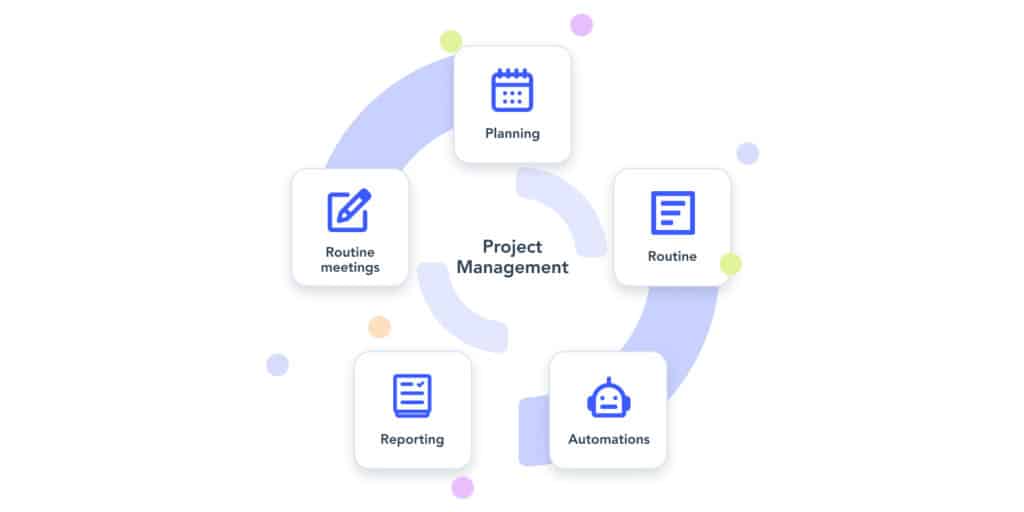ARTICLE SUMMARY
Projects and processes have key differences. Depending on the end result trying to be achieved, one may be more suited than the other. Learn more.

The Project vs. Process comparison is often discussed, and every single manager probably has already asked themselves about which one is better.
Both projects and processes are important for running and improving a business. However, depending on the end result that you’re trying to achieve, one may be more suited than the other.
For example, let’s suppose that a company wants to implement new cross-functional software that will be more secure and boost overall productivity. The goal is a 100% adoption rate in less than four months. In this scenario, you’ll need a project—one that will incorporate many department leaders and follow the designing, implementation and adoption phases of the new software.
In another scenario, a sales manager notes that sales reps are taking too long to reach out to new leads in their pipeline. However, up to this point, the manager has little data to determine if this is caused by understaffing or by a lack of a better approach to clear out the pipeline. In this case, improving the process through which sales reps clear out their pipeline and tracking their steps would have better results than implementing a project.
What is a project?
A project usually has three aspects in common:
- Fixed time
- Defined scope
- Resources
While implementing a project, the goal is to perform changes, usually drastic, and to incorporate said changes into the company’s day-to-day processes.
If we can simplify how we see a project, it is something that must be delivered within a certain timeline. A project is a collaborative effort to develop a unique product, service or goal. It’s an endeavor to build something that daily activities are not able to fulfill.
What is a process?
A process is defined by cycles. Similarly to a project, a process also has a beginning, middle, and end; however, this cycle repeats itself over an average period of time.
Let’s see a Finance department example. This department receives dozens of purchases requests every week. The department doesn’t have a time-boxed deadline to deliver every single purchase. The team has repetitive requests that must be executed over and over. This is a process!
To better manage this financial team, the best option is to create a pattern. They must understand what information the company needs and to keep track of what is going on.
Unlike the example project, delivering purchase requests won’t build something unique for the company and it doesn’t have a deadline, but developing a process for the team by gathering the necessary data will improve the company’s results.
Project vs. Processes: benefits
Before we hash out how to create each one of them from scratch, knowing the main benefits of each method is important to understand the value of each management type.
Project benefits
- Budget definition: you know how much you are going to spend
- Collaboration among co-workers: you improve teamwork in your company
- Results definition: you know which results you can expect
- Expected date to launch: you can use the date to make a big announcement to all markets and inside the company
- Schedule definition: you have a clear understanding of when you are going to see activities in action
- Huge delivery/contribution: a new product, service or a big contribution will be delivered to your company
Process benefits
- It gives a structured pattern to what your employees will do: use best practices and don’t lose sight of essential information
- Allows you to control results, and improve takt time and cycle time
- Database: by running a process, your team becomes data-driven and advances their actions by data
- Clear understanding of what has to happen: get a clear understanding of what each team member is doing
- Bottleneck identification: easily understand your wastes
How to improve project management

Although most project management tools aren’t compatible with process management, projects are run better when there’s an underlying process to their execution.
Here are some process practices that will quickly improve your project management:
Standardize planning
Although every project is unique, the planning process shouldn’t have to be. The more regularized the planning process is, the less likely important factors will go without consideration.
Practice routine expense and time logging
Not only will routine expense and time logging help keep track of finances, but it will also help you find bottlenecks in performance.
Set-up automated billing
The more you automate and systematically track predictable tasks, such as billing, the more you can focus on dynamic aspects of the project.
Consolidate and standardize reporting
Frequent and thorough reports are key for preventing scope creep and delivering within the budget.
Conduct routine meetings that stay on topic
Routine meetings help all team members to stay on track, keep up to date with project changes and hold themselves more accountable for their deliverables.
How to improve process management

If your company currently uses a business process management (BPM) software, it’s much easier to use data to find bottlenecks and determine areas for improvement. However, if your company is new to BPM, here are a few initial steps to improve your business processes:
Identify key business processes
Start your process management by pinpointing key processes that keep the business, or your department, running effectively.
Map out the key processes
To implement a process management software, a process map is a good tool to get a bird’s eye view of your processes.
Determine how the processes can be improved
With your bird’s eye view, it may be easier to find bottlenecks, opportunities to streamline work or approvals, and pinpointing steps that can be automated.
Next steps to improve your business management
Now that you understand the importance of projects and processes and how you can improve your daily work management, it’s time to think about the next steps. Having a specialized tool for the type of management you want to implement is essential to be successful.
So take a look at Pipefy’s best use cases and start improving your team’s execution:










